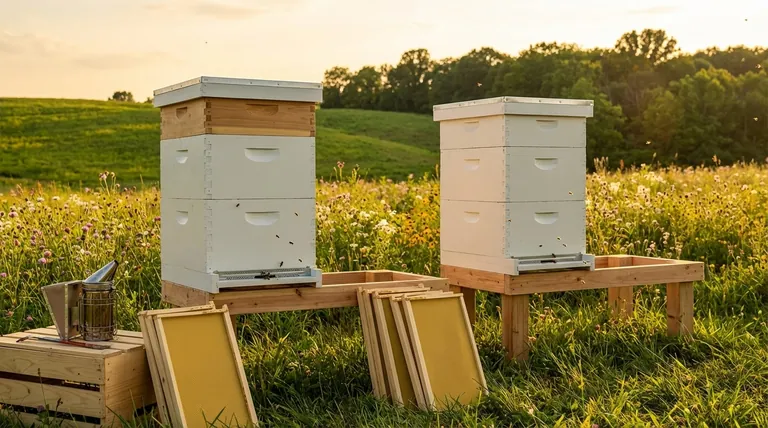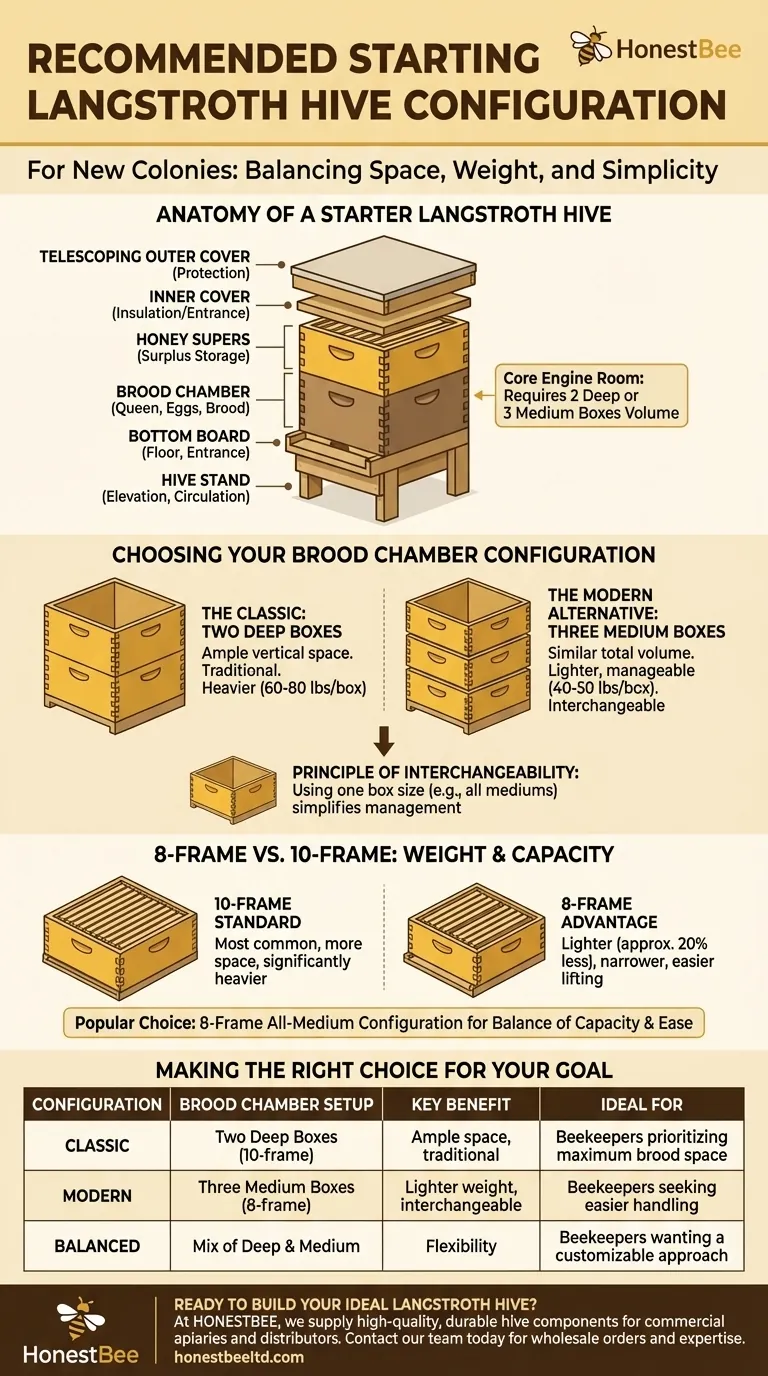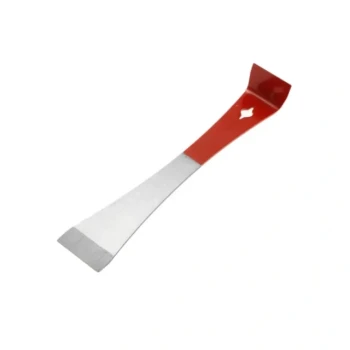For a new Langstroth hive, the recommended starting configuration is a brood chamber with a volume equivalent to either two deep hive bodies or three medium hive bodies. This core setup provides the necessary space for a new colony to raise brood and store enough resources to survive its first winter. Your choice between these options, as well as between 8-frame and 10-frame equipment, depends on your preferences for weight and operational simplicity.
The central decision in your first hive setup is balancing the colony's need for space against your physical ability to manage the equipment. Choosing an all-medium box configuration, particularly in an 8-frame size, is a popular modern approach that prioritizes lighter weight and complete interchangeability of parts.

Anatomy of a Starter Langstroth Hive
Before choosing a configuration, it's essential to understand the function of each component. A hive is a modular system designed to protect and house the colony.
The Foundation: Stand and Bottom Board
Your hive should be elevated off the ground on a hive stand. This improves air circulation, deters pests, and makes inspections easier on your back.
The hive itself rests on a bottom board, which serves as the floor and provides the main entrance for the bees. Screened bottom boards are a common choice as they offer superior ventilation and help in monitoring for varroa mites.
The Core: Hive Bodies and Frames
Hive bodies, or boxes, are the primary structure where bees live. The boxes at the bottom of the hive are the brood chamber, dedicated to the queen for laying eggs and raising new bees.
Boxes added on top of the brood chamber are called honey supers, used by the bees for storing surplus honey.
Inside each box are frames, which hold sheets of foundation made of wax or plastic. This foundation provides a guide for the bees to build straight, uniform honeycomb, making the hive easy to inspect.
The Protection: Inner and Outer Covers
An inner cover sits on top of the uppermost box, providing a layer of dead air space for insulation and an upper entrance if needed.
Finally, a telescoping outer cover fits over the top of the hive, protecting the colony from rain, sun, and other weather elements.
Choosing Your Brood Chamber Configuration
The most critical choice for a new hive is the size and number of boxes for the brood chamber. This is the colony's engine room.
The Classic: Two Deep Boxes
The traditional configuration uses two deep (9 5/8" high) boxes for the brood chamber. This setup provides ample, uninterrupted vertical space for the queen's laying pattern.
This is the most common method taught in older literature, and it works exceptionally well. Its main drawback is weight; a full deep box can weigh 60-80 pounds.
The Modern Alternative: Three Medium Boxes
A popular alternative is to use three medium (6 5/8" high) boxes for the brood chamber. This provides a very similar total volume to two deep boxes.
The primary advantage is that the weight is distributed across three lighter, more manageable units. A full medium box typically weighs 40-50 pounds.
The Principle of Interchangeability
Using a single box size (e.g., all mediums) for the entire hive—both brood chamber and honey supers—creates a system where every part is interchangeable. This simplifies management, as any box of drawn comb can be moved anywhere in the hive it is needed.
Understanding the Trade-offs: 8-Frame vs. 10-Frame
Langstroth equipment comes in two standard widths. This choice affects weight, capacity, and compatibility.
The 10-Frame Standard
The original Langstroth design holds 10 frames. This is the most common size, meaning equipment is widely available. It offers more space per box, which can mean fewer boxes are needed for honey storage. However, it is significantly heavier.
The 8-Frame Advantage
The 8-frame system was developed as a lighter-weight alternative. Each box is narrower and, when full, is about 20% lighter than its 10-frame equivalent. This makes it a preferred choice for beekeepers who want to avoid heavy lifting.
While not compatible with 10-frame equipment, the 8-frame system is very popular and well-supported, so finding parts is not difficult. Many beekeepers find the combination of 8-frame boxes in an all-medium configuration to be the ideal balance of capacity and ease of handling.
Making the Right Choice for Your Goal
Your initial setup determines your management style for years to come. Base your decision on your physical comfort and desired simplicity.
- If your primary focus is minimizing heavy lifting: Choose an 8-frame hive and use all medium boxes for both the brood chamber and honey supers.
- If your primary focus is the most traditional path: Start with a 10-frame hive using two deep boxes for the brood chamber and medium boxes for honey supers.
- If your primary focus is operational simplicity: Select a single box size (either deeps or mediums) for your entire hive so that all components are fully interchangeable.
Choosing a common hive style like the Langstroth empowers you with a wealth of resources and a clear path to getting started.
Summary Table:
| Configuration | Brood Chamber Setup | Key Benefit | Ideal For |
|---|---|---|---|
| Classic | Two Deep Boxes (10-frame) | Ample space, traditional | Beekeepers prioritizing maximum brood space |
| Modern | Three Medium Boxes (8-frame) | Lighter weight, interchangeable parts | Beekeepers seeking easier handling |
| Balanced | Mix of Deep & Medium | Flexibility | Beekeepers wanting a customizable approach |
Ready to build your ideal Langstroth hive?
At HONESTBEE, we supply commercial apiaries and beekeeping equipment distributors with the highest-quality, durable hive components. Whether you're standardizing on 8-frame mediums for ease of use or need robust 10-frame deeps, our wholesale-focused operations ensure you get the right equipment for your specific goals.
Let our expertise guide your setup. Contact our team today to discuss your needs and place your order!
Visual Guide

Related Products
- Langstroth Bee Hives Bee Keeping Box for Beginners Beekeeping
- HONESTBEE Professional Multi-Functional Hive Tool with Ergonomic Wood Handle
- HONESTBEE Advanced Ergonomic Stainless Steel Hive Tool for Beekeeping
- HONESTBEE Professional Long Handled Hive Tool with Precision Cutting Blade
- Multi-Function Plier-Style Frame Grip Hive Tool
People Also Ask
- Should a beginner try a different type of hive? Start with a Langstroth for a solid foundation.
- What are the different types of beehive boxes available? Choose the Right Hive for Your Apiary
- Why might a beginner be advised to start with a Langstroth hive? Unlock a Supportive Beekeeping Ecosystem
- What are the key features of the Langstroth beehive? A Guide to the Standard for Modern Beekeeping
- How does the ease of access differ between 8-frame and 10-frame hives? Choose the Right Hive for Your Body



















